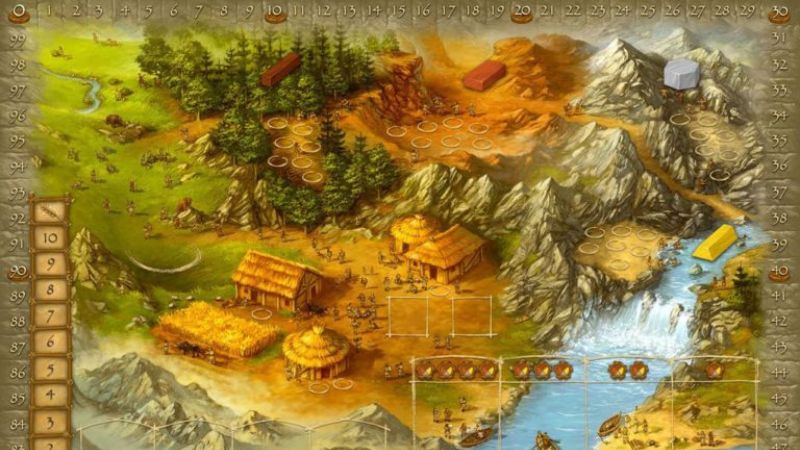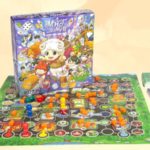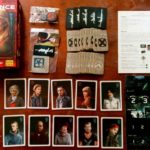Board games have always been a fun pastime, but have you heard of Stone Age? This unique board game takes you back to the Stone Age, offering a fun and immersive experience. Join Bach Hoa XANH as we explore the ins and outs of this captivating game, perfect for family game nights and get-togethers with friends.
1. Introduction to the Stone Age Board Game
Stone Age is a captivating board game designed by Michael Tummelhofer and published by Hans im Gluck in 2008. The game immerses players in the Stone Age, tasking them with managing a tribe, gathering resources, and building a powerful village.
Inspired by the lives of our prehistoric ancestors, Stone Age challenges players to strategize and plan their moves to collect the most food and resources. While skill plays a significant role, a bit of luck is also needed to emerge victorious in this game!
For more insights: Detailed Guide to Stone Age Board Game
 Introduction to Stone Age Board Game
Introduction to Stone Age Board Game
2. Quick 5-Minute Guide to Stone Age Board Game Rules
Components of the Stone Age Board Game
The Stone Age board game includes the following components:
- 1 large game board
- 4 player boards
- 58 wooden resources
- 40 Meeple (prehistoric people)
- 8 seals in 2 sizes
- 53 food pieces
- 28 building cards
- 18 tool cards
- 1 chief figure (tribe leader)
- 36 civilization cards
- 7 dice
- 1 dice cup
- 1 instruction manual
For detailed instructions: Comprehensive Guide to Stone Age Board Game
 Components of the Stone Age Board Game
Components of the Stone Age Board Game
Winning Conditions for Stone Age
A game of Stone Age ends when there are not enough Civilization cards left to fill the spaces at the start of a new round, or when one of the stacks of Building tiles has been depleted.
If there are insufficient Civilization cards to fill the spaces, the game ends immediately. If a stack of Building tiles is empty, the current round is completed, including feeding the Meeple, and then the game ends, proceeding to the scoring phase.
At the end of the game, the player with the most points wins. Scoring is based on the following criteria:
- Cards
- Current points
- Remaining resources
 Stone Age Board Game Rules
Stone Age Board Game Rules
3. How to Play the Stone Age Board Game
Setting Up the Game
 Placing the Stone Age Game Board
Placing the Stone Age Game Board
 Placing Food and Resource Pieces
Placing Food and Resource Pieces
 Separating the Tools
Separating the Tools
 Shuffling and Placing the Cards
Shuffling and Placing the Cards
 Different Areas and Points for Resources in Stone Age
Different Areas and Points for Resources in Stone Age
 Setting Up Stone Age
Setting Up Stone Age
Starting the Game
Each round of Stone Age consists of three phases: placing Meeple on the game board, using the actions of the placed Meeple, and feeding the Meeple.
Phase 1: Placing Meeple on the Game Board
In this phase, players take turns placing their Meeple on different areas of the board. Each region has a specified number of circles, indicating the maximum number of Meeple allowed in that location. The phase ends when all players have placed their Meeple on the board.
Note that during a round, players can only place their Meeple in a location once. For example, if Yellow has already placed 4 Meeple in the forest, they cannot place any more Meeple there during that round.
Areas in Stone Age and Maximum Meeple Allowed
 Areas in Stone Age and Maximum Meeple Allowed
Areas in Stone Age and Maximum Meeple Allowed
- Tool Workshop (1 Meeple): Provides additional dice for resource gathering.
- Hut (2 Meeple): A reproduction hut that increases the workforce.
- Farm (1 Meeple): Reduces the amount of food needed to feed Meeple at the end of a round.
- Hunting Area (No Limit): Provides food through hunting, independent of agriculture.
- Resource Areas (Forest, Clay Mound, Stone Mine, River – Maximum of 7 Meeple/Area): Used for constructing buildings, purchasing cards, and paying food based on the number of Meeple and the level of agriculture.
Types of Cards in Stone Age
- Civilization Cards: Each card can accommodate only one Meeple. Occupying these cards is not dependent on a specific order.
- Building Tiles or Construction Cards: Each card can accommodate only one Meeple. Occupying these cards is not dependent on a specific order.
 Types of Cards in Stone Age
Types of Cards in Stone Age
Once all the Meeple have been placed on the board or there are no more spaces available, proceed to the next phase.
Phase 2: Using the Actions of the Placed Meeple
In this phase, players will activate the actions associated with the Meeple they wish to move, and the Meeple will return to the player. This phase starts with the first player (holding the chief figure) and continues with the other players in a clockwise direction. This process is repeated until all the Meeple on the board have been retrieved.
Actions in Different Areas
Tool Workshop: Each player will take a Tool tile with the number 1 and place it face up on their personal information board. Tool tiles can be upgraded as follows:
- From the 2nd to 3rd Tool tile, the player pays a Tool tile with a value of 1.
- From the 4th to 6th Tool tile, the player exchanges a Tool tile with a value of 1 for one with a value of 2.
- From the 7th Tool tile onwards, the player exchanges a Tool tile with a value of 2 for one with a value of 3.
- From the 10th Tool tile onwards, the player exchanges a Tool tile with a value of 3 for one with a value of 4.
During a round, each Tool tile can only be used once. Tool tiles are used when rolling dice to gather resources, and after use, they should be rotated 90 degrees to indicate that they have been utilized.
- Hut: This is a reproduction hut that generates additional workforce. If Yellow places 2 Meeple in the hut, they will retrieve 3 Meeple and place them all on their player board.
- Farm: When a Meeple is placed here and moved to the food track, crop production increases, and more food is received at the end of each round.
- Hunting Area: The amount of food obtained through agriculture is insufficient to feed the tribe, so additional food must be obtained from the hunting area. Players roll the dice corresponding to the number of Meeple in this area. The amount of food obtained is calculated using the following formula:
Number of Food = Total Dice Roll / 2 (rounded down) - Resource Areas: These areas are used to collect Wood, Clay, Stone, or Gold. The formula for calculating the number of resources collected is similar to that for food, but the total dice roll is divided by different numbers:
Forest: Divide by 3
Clay Mound: Divide by 4
Stone Mine: Divide by 5
River: Divide by 6
It is important to note that the total dice roll must be greater than or equal to the divisor; otherwise, no resources will be obtained.
 Actions in Different Areas
Actions in Different Areas
Obtaining Civilization and Building Cards
To obtain Civilization cards, players must use the resources they have gathered, exchanging them according to the values specified on the cards. The resources used will then be returned to their original locations. If a player does not want or cannot make an exchange, they can retrieve their placed Meeple and leave the card in its place. Once obtained, Civilization cards are placed face down on the player’s personal board.
For Building cards, players exchange resources for a house. Similarly, the resources used are returned to their original locations, and the scoring marker is moved up (based on the values specified on the Building card). The next Building card is then revealed.
Among the Building cards, eight allow players to choose the type of resource to exchange, but not the quantity. Three cards allow players to choose both the quantity (up to 7) and the type of resource to exchange. Points are calculated as follows:
Number of Points = Resource Value / Number of Resources (Exchanged)
Scoring for Different Types of Houses
 Scoring for Different Types of Houses
Scoring for Different Types of Houses
The points for the acquired resources are recorded on the player’s personal information board.
Phase 3: Feeding the Meeple
After retrieving all the Meeple from the board, players must feed each Meeple.
Unlocking Strategies for Winning the Comet Race Board Game from Experienced Classroom Code Talkers
Are you up for the challenge? Compete against your friends and family in Comet Race – the thrilling new board game that puts your skills to the test! Battle to collect the most supply crates before an oncoming comet crashes into the shops and destroys them! Who will be the master of the board? Find out now with Comet Race!
“Most Popular Board Games for a Group of Four Players”
Are you searching for a fun and engaging way to get your group of four together? Look no further than some classic board games! Pandemic, Catan, and Codenames are all great options if you’re seeking a fun opportunity to bond with your squad.
Exploring Deception and Murder in the Hong Kong Board Game
Do you have what it takes to uncover the truth and apprehend the killer? Put your detective skills to the test in Deception: Murder in Hong Kong, the deduction game of murder mystery and intrigue. Deduce the murderer, the weapon used and the secret evidence from the crime scene. With plenty of plot twists to keep you guessing, can you solve the puzzle and get to the bottom of the case?



































